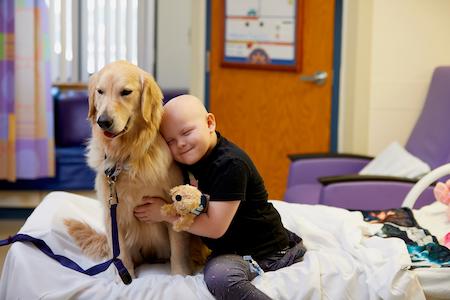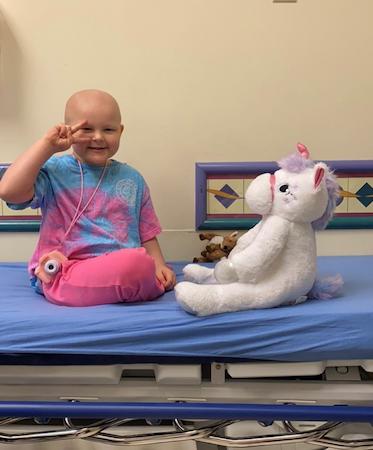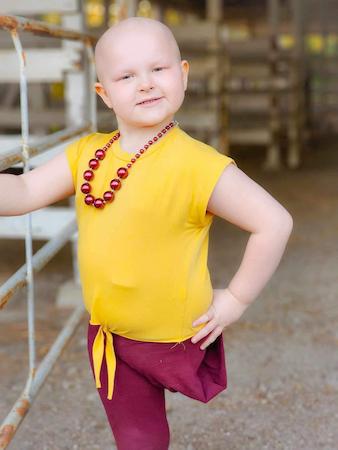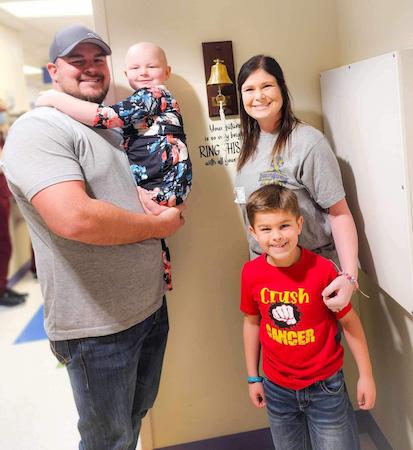Osteosarcoma: Lexy's Story
Meet Lexy

Lexy is a strong-willed five-year-old who loves art projects, tater tots, facility dog Jellybean and her big brother, Klay. Her fierce disposition has led the way during a challenging cancer diagnosis — and will continue to serve her well as a kid growing up with a limb difference.
“Lexy is fierce in all of the best ways,” said Matthew McLaughlin, MD, MS, FAAPMR, Division Director, Pediatric Rehabilitation Medicine. “She’s been fierce through her chemo. She was fierce through her surgery. She’s fierce in her recovery. She’s a strong-minded individual, even stronger-minded than most 5-year-olds!”
A “storm” in her leg

On March 13, 2023, Lexy’s grandparents noticed her left leg was swollen and hard. Lexy’s mom, Breanna Hyman, took her to their local hospital, where they were transferred to Children’s Mercy Kansas City for tests.
“We got to Children’s Mercy at two o’clock in the morning, and we immediately had a team waiting for us,” said Breanna. Lexy, Breanna, and Breanna’s mom, Renee, settled in and met with the Oncology team the next morning. Lexy’s dad, Kyle Rentfro, joined them in time for her bone biopsy.
With input from colleagues at the University of Kansas, Lexy was diagnosed with osteosarcoma, the most common form of pediatric bone cancer. As Lexy described it: There was a storm in her leg.
Joel Thompson, MD, Co-Medical Director for Quality and Safety and an oncologist in the Division of Hematology, Oncology and Blood and Marrow Transplantation, walked Lexy’s family through the treatment protocol: 10 weeks of chemotherapy, surgery to remove the cancer, a few weeks of recovery time, then 18 more weeks of chemotherapy.
Lexy’s team faced a unique challenge: As an infant, she was diagnosed with Phenylketonuria (PKU) — a genetic inability to break down the amino acid phenylalanine that can cause severe brain damage if left untreated. Lexy is on a low-protein diet to limit phenylalanine and prevent PKU symptoms, which can range from eczema to seizures to intellectual disabilities.
“This was a new frontier for us,” said Dr. Thompson. “We looked through the literature to see how other medical teams manage chemotherapy for kids with PKU, and there’s not a lot out there.”
A multidisciplinary team, including geneticists and nutritionists from the Genetics Clinic and metabolic dieticians, came up with a monitoring and feeding plan to keep Lexy strong. They used a gastrostomy tube (G-tube) to deliver PKU-friendly nutrition and reduced the volume of platelet transfusions during chemotherapy because of their high protein content. “That G-tube was a lifesaver because her taste buds changed, and she wouldn’t drink her special [PKU] formula anymore,” said Breanna.
Considering all the options
The family prepared for chemo as best they could. Lexy’s aunt, a hairstylist, dyed Lexy’s hair purple, knowing she would be losing it soon. Kyle shaved his head in support. They also began discussing their surgical options with John Krumme, MD, orthopedic surgeon, and the rest of her care team.
“Her disease was extensive, which meant her options were a little bit different,” said Dr. Krumme.
Lexy’s family needed to choose between amputation at the hip or extensive reconstruction. Amputation offered the best chance of removing all the cancer, lower recurrence risks and no anticipated follow-up surgeries. Alternatively, the team could implant an artificial femur that would require full hip and knee replacements and additional surgeries as Lexy grew.
“Even if everything goes perfectly, you’d need three or four surgeries at least,” said Dr. Krumme. “And after all that, the chance that she gets a normally functioning leg is zero.”

As Breanna and Kyle weighed the pros and cons, Breanna’s cousin sent a video of a local 14-year-old playing softball with a prosthetic leg . It helped them envision the possibilities of living with a limb difference.
“Our goal for her life is no pain, no medicine, happy life,” said Breanna. Lexy’s family talked through the very hard decision they needed to make together. It was an extensive deliberation process. Finally, they decided that amputation would give Lexy the best chance at the happy life they all wanted for her. Breanna and Kyle prepared Lexy for what amputation would mean. Her surgery was on June 5.
“When she woke up, she wiggled a little bit and said the storm was all gone,” remembered Breanna. “She’s a very intelligent little girl. She handled all of this better than I think her dad and I did.”
“I really respected her mom and dad being able to get on the same page and make decisions together that were well thought out and reasonable,” said Dr. Krumme. “They did a good job of using all the resources the hospital had to offer.”
Life on Lexy’s terms
After a break to let Lexy heal, she began chemotherapy again in early July. In November, Lexy’s scans came back clear: She was officially in remission. She’ll continue getting scans every three months for the first year, and then regularly after that.
Lexy and her family met with the Limb Differences Clinic that fall. The team includes rehabilitation physicians and nurse practitioners, physical and occupational therapists and prosthetists.
“The biggest question we always ask at the beginning is what does Lexy want to do with her life?” said Dr. McLaughlin. “We help align her goals with what we want to do prosthetically.”
The team worked with Loren Decker, CP, of Decker Integrated Orthotics, to create Lexy’s first prosthetic, which was delivered in January. Lexy began working with Nathan Apple, PT, Manager of Clinical Physical Therapy, to adjust to her limb difference. She comes in every other week for physical therapy and follows a home program as well.
“First and foremost, we address function,” said Nathan. “How can we get patients back to a functional level that is peer appropriate?”
The higher the leg amputation, the more energy it takes to operate the prosthetic. “It’s hard, heavy, and she gets tired,” said Nathan. “Our main goal right now is increased wear time.”
Lexy will work on using the prosthetic with a walker, then with arm crutches, before progressing to independent use. Nathan will continue to tailor physical therapy to Lexy’s goals as she grows.
“Right now, our goal is to just let Lexy do what she’s going to do,” said Breanna, who is looking forward to seeing what Lexy will accomplish in the future. “She wants to do gymnastics. Her upper-body strength is crazy.”
“She’s a hoot of a kid, and she’s super fun to work with,” said Nathan. “She’s going to do it on her own terms, and it’s apparent early on that’s going to help. She’s her own best advocate.”

A few weeks ago, Lexy and her family ran into a familiar figure in the Children’s Mercy hallway: the teenaged softball player who inspired them early in their limb differences journey. Lexy is making friends with other kids with limb differences and adapting to life after cancer.
“She’s more positive; she wants to try more new things now,” Breanna said. “She’s still a spunky little attitude girl!”
Breanna said that the resources at Children’s Mercy were very helpful, especially Child Life, caring nurses and CAs, and the Facility Dog Program. Inspired by their time with Jellybean, they are looking into getting Lexy her own therapy dog.
“I learned that life is too short, and it will throw you a curveball every now and then,” said Breanna. “But your family and the support system at Children’s Mercy is honestly the only way you’re going to get through it.”
